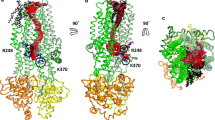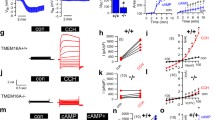Abstract
CYSTIC fibrosis transmembrane conductance regulator (CFTR) is a plasma membrane Cl− channel regulated by cyclic AMP-dependent phosphorylation and by intracellular ATP1–7. Mutations in CFTR cause cystic fibrosis8–10 partly through loss of cAMP-regulated Cl− permeability from the plasma membrane of affected epithelia11,12. The most common mutation in cystic fibrosis is deletion of phenylalanine at residue 508 (CFTRΔF508) (ref. 10). Studies on the biosynthesis13,14 and localization15 of CFTRΔF508 indicate that the mutant protein is not processed correctly and, as a result, is not delivered to the plasma membrane. These conclusions are consistent with earlier functional studies which failed to detect cAMP-stimnlated Cl− channels in cells expressing CFTRΔF508 (refs 16,17). Chloride channel activity was detected, however, when CFTRΔF508 was expressed in Xenopus oocytes18, Vero cells19 and Sf9 insect cells20. Because oocytes and Sf9 cells are typically maintained at lower temperatures than mammalian cells, and because processing of nascent proteins can be sensitive to temperature21, we tested the effect of temperature on the processing of CFTRΔF508. Here we show that the processing of CFTRΔF508 reverts towards that of wild-type as the incubation temperature is reduced. When the processing defect is corrected, cAMP-regulated Cl− channels appear in the plasma membrane. These results reconcile previous contradictory observations and suggest that the mutant most commonly associated with cystic fibrosis is temperature-sensitive.
Similar content being viewed by others
References
Anderson, M. P. et al. Science 253, 202–205 (1991).
Bear, C. E. et al. Cell 68, 809–818 (1992).
Tabcharani, J. A., Chang, X.-B., Riordan, J. R. & Hanrahan, J. W. Nature 352, 628–631 (1991).
Berger, H. A. et al. J. clin. Invest. 88, 1422–1431 (1991).
Rich, D. P. et al. Science 253, 205–207 (1991).
Cheng, S. H. et al. Cell 66, 1027–1036 (1991).
Anderson, M. P. et al. Cell 67, 775–784 (1991).
Rommens, J. M. et al. Science 245, 1059–1065 (1989).
Riordan, J. R. et al. Science 245, 1066–1073 (1989).
Kerem, B. et al. Science 245, 1073–1080 (1989).
Boat, T. F., Welsh, M. J. & Beaudet, A. L. in The Metabolic Basis of Inherited Disease Vol. 6 (eds Scriver, C. R., Beaudet, A. L., Sly, W. S. & Valle, D.) 2649–2680 (McGraw-Hill, New York, 1989).
Quinton, P. M. FASEB J. 4, 2709–2717 (1990).
Cheng, S. H. et al. Cell 63, 827–834 (1990).
Gregory, R. J. et al. Molec. cell. Biol. 11, 3886–3893 (1991).
Denning, G. M., Ostedgaard, L. S. & Welsh, M. J. J. Cell Biol. 118, 551–559 (1992).
Rich, D. P. et al. Nature 347, 358–363 (1990).
Anderson, M. P., Rich, D. R., Gregory, R. J., Smith, A. E. & Welsh, M. J. Science 251, 679–682 (1991).
Drumm, M. L. et al. Science 254, 1797–1799 (1991).
Dalemans, W. et al. Nature 354, 524–528 (1991).
Bear, C. E., Jensen, T. J. & Riordan, J.R. Biophys. J. 61, A127 (1992).
Machamer, C. E. & Rose, J. K. J. biol. Chem. 263, 5955–5960 (1988).
Ljunggren, H.-G. et al. Nature 346, 476–480 (1990).
Kartner, N. et al. Cell 64, 681–691 (1991).
Gilbert, I. A., Fouke, J. A. & McFadden, E. R. Jr J. appl. Physiol. 63, 1681–1691 (1987).
Deal, E. C. Jr, McFadden, E. R. Jr, Ingram, R. H. Jr & Jaeger, J. J. J. appl. Physiol. 46, 484–490 (1979).
Author information
Authors and Affiliations
Rights and permissions
About this article
Cite this article
Denning, G., Anderson, M., Amara, J. et al. Processing of mutant cystic fibrosis transmembrane conductance regulator is temperature-sensitive. Nature 358, 761–764 (1992). https://doi.org/10.1038/358761a0
Received:
Accepted:
Issue Date:
DOI: https://doi.org/10.1038/358761a0
- Springer Nature Limited
This article is cited by
-
Tuning phenylalanine fluorination to assess aromatic contributions to protein function and stability in cells
Nature Communications (2023)
-
A novel role for CFTR interaction with LH and FGF in azoospermia and epididymal maldevelopment caused by cryptorchidism
Basic and Clinical Andrology (2022)
-
Spatial covariance analysis reveals the residue-by-residue thermodynamic contribution of variation to the CFTR fold
Communications Biology (2022)
-
Esc peptides as novel potentiators of defective cystic fibrosis transmembrane conductance regulator: an unprecedented property of antimicrobial peptides
Cellular and Molecular Life Sciences (2022)
-
Update zur Therapie der CF bei Kindern und Jugendlichen
Der Pneumologe (2022)





